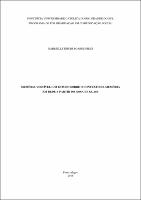| Share record |


|
Please use this identifier to cite or link to this item:
https://tede2.pucrs.br/tede2/handle/tede/6720| Document type: | Dissertação |
| Title: | Memória vestível : um estudo sobre o contexto da memória em rede a partir do Google Glass |
| Author: | Pires, Gabrielli Tiburi Soares  |
| Advisor: | Pellanda, Eduardo Campos |
| Abstract (native): | A mobilidade informacional proporcionou diversas transformações culturais, entre elas um novo tipo de nomadismo, com o qual passamos a nos comunicar e produzir conteúdo em qualquer momento. Com a entrada dos wearables (computadores vestíveis) no mercado, passamos a ter uma ligação mais íntima da tecnologia com o corpo. Dispositivos always on captam nossas informações e atuam de forma independente, armazenando e evocando-as quando necessário. A partir destas transformações tecnológicas reside também uma constante preocupação com a memória. Nossa produção de informações, como uma forma de externalizar a memória, é crescente e está ligada ao nosso modo de vida nômade proporcionado pelas tecnologias informáticas. Em busca de compreender as relações da memória social e frente ao cenário dos wearables, o presente trabalho analisa a produção fotográfica do Google Glass com objetivo de problematizar a externalização da memória através dos computadores vestíveis, como um primeiro olhar sobre o tema. Os principais autores utilizados no embasamento teórico desta pesquisa foram Halbwachs, Le Goff, Garde-Hansen, Dijck, Ernst, Maffesoli, Lemos, Mitchell, McLuhan e Mann. A partir do método da Analítica Cultural, utilizado para analisar grandes volumes de imagem de forma computadorizada, foram desenvolvidas diferentes visualizações de mídia a partir de informações extraídas de 680 imagens capturadas pela câmera do Google Glass e publicadas no Flickr com licença Creative Commons, durante 13 meses. Os resultados encontrados dividem-se entre pontos de ruptura e pontos de continuidade em relação a fotografia e a memória. Há indícios nas fotografias analisadas de repetição de enquadramentos e de temáticas que são tradicionais da fotografia e que são pertencentes a uma memória coletiva. Entretanto, é possível identificar, também, elementos constituintes de uma linguagem própria, ocasionada pelo uso do Google Glass. A posição da câmera acima dos olhos de quem veste esse dispositivo imprime um ponto de vista que pode impactar na evocação das memórias posteriormente. Traços indicativos da aprendizagem em relação ao uso deste wearable, a predominância de fotografias ao ar livre e formas de fazer-se presente nas fotografias também ajudam a formar uma identidade destas imagens através do que podem influenciar na memória. |
| Abstract (english): | Informational mobility has made possible various cultural transformations, among these transformations there is a new kind of nomadism, with wich we came to comunicate and produce content any time. As the wearables arrived to the Market, we began to have an intimate relation between technology and our body. Always on devices capture our information and act independently, storaging and evoking them when necessary. From these tecnological transformations resides also a constant concern with memory. Our production of information as a way to externalize the memory is growing and is related to our nomadic way of life provided by computing tecnologies. In order to understand the relations of social memory and facing the wearables scenario, the present work analises the photographic production in Google Glass aiming to discuss the externalization of memory through wearable computers, as a first look at the issue. The main authors used to theoretical basis of this research were Halbwachs, Le Goff, Garde-Hansen, Dijck, Ernst, Maffesoli, Lemos, Mitchell, McLuhan and Mann. Trough the method of Cultural Analytics, used to analyze huge volumes of image in a computerized way, there were developed different media views from information extracted from 680 images taken by Google Glass camera and posted on Flickr under Creative Commons license for 13 months. The results are divided into points of rupture and points of continuity in relation to photography and memory. There are evidences in the analyzed photographs of repetition of frameworks and themes that are traditional in photography and that are owned by a collective memory. However, we can also identify constituent elements of a language, brought by the use of Google Glass. The position of the camera above the eyes of the wearer print a point of view that can impact the evocation of memories afterwards. Indicative traits of learning in relation to the device, the predominance of outdoor photographs and forms of being present in the photographs also help to form an identity of these images through what they can influence memory. |
| Keywords: | MEMÓRIA SOCIAL FOTOGRAFIA TECNOLOGIA DA INFORMAÇÃO COMUNICAÇÃO SOCIAL |
| CNPQ Knowledge Areas: | CIENCIAS SOCIAIS APLICADAS::COMUNICACAO |
| Language: | por |
| Country: | Brasil |
| Publisher: | Pontifícia Universidade Católica do Rio Grande do Sul |
| Institution Acronym: | PUCRS |
| Department: | Faculdade de Comunicação Social |
| Program: | Programa de Pós-Graduação em Comunicação Social |
| Access type: | Acesso Aberto |
| URI: | http://tede2.pucrs.br/tede2/handle/tede/6720 |
| Issue Date: | 30-Mar-2016 |
| Appears in Collections: | Programa de Pós-Graduação em Comunicação Social |
Files in This Item:
| File | Description | Size | Format | |
|---|---|---|---|---|
| DIS_GABRIELLI_TIBURI_SOARES_PIRES_COMPLETO.pdf | Texto Completo | 7.48 MB | Adobe PDF |  Download/Open Preview |
Items in DSpace are protected by copyright, with all rights reserved, unless otherwise indicated.




